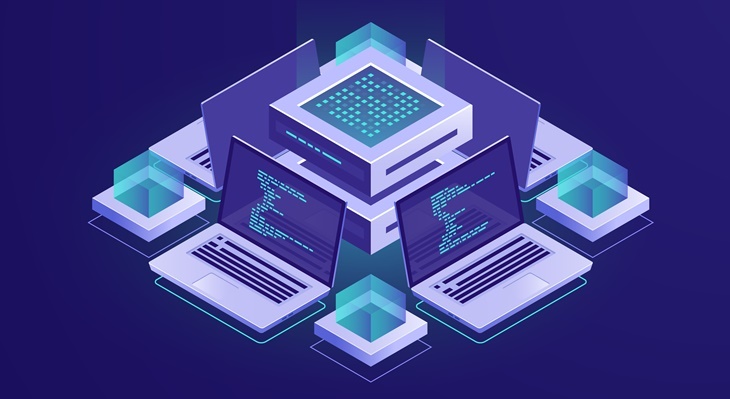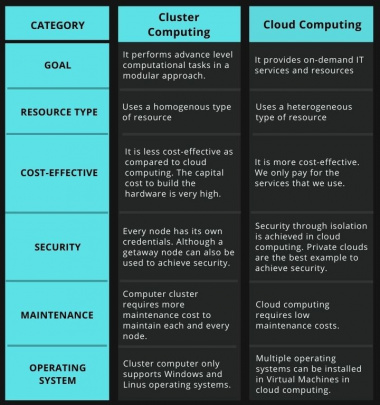Cluster computing is a set of computers connected via a network. This set of computers together form a single system and executes operations altogether. Clustering solves complicated problems with much faster computational speed. It gives better data integrity than a single computer.
Google search engine, Earthquake simulations, Weather forecasting uses clustering techniques. So what is it? The various types and advantages we will see in this article.
What is Cluster Computing and how it is different from Cloud Computing?
Cluster Computing
Cluster computing is a technique in which we connect multiple computers via a network and it works as a single entity. These connected computers form a cluster. When we connect a computer to this network it is called a node.
The connected computers perform operations altogether. Hence it provides faster computational speed. We connect computers to the network through fast local area networks (LANs). Clustering computers is not expensive as compared to large servers. Moreover, it ensures that the computational space is always available.
Characteristics:
- To form a Cluster the computers connected must be of the same kind.
- Connect all computers via LAN to ensure strong connectivity.
- The computers should share a common directory.
Classifications:
Cluster computers are classified into two different categories based on security.
- Open Cluster: All computers need IP addresses in the Open cluster. These IPs are available on the internet which is a security concern.
- Close Cluster: All the nodes hide behind the gateway node. This gateway node increases the protection of other nodes.
Cluster computing architecture
An array of interconnected standalone computers forms a cluster. The cluster can be a distributed or parallel processing network where computers operate all together to form a single system.
A node is an individual machine that has an operating system with memory and input/output functions.
It’s not mandatory that every computer must be connected separately through the LAN connection, two or more nodes can also be connected to a single line.
Examples of cluster computing
- Aerodynamics and data mining applications use the clustering process.
- Fast image rendering can also be done by using the clustering technique.
- It is also used in weather forecasting techniques.
- Multiple E-commerce websites use it for faster computational speed.
- We use clustering techniques to solve complex computational problems.
- Forecasting occurrence of tornadoes and earthquakes.
- Lastly, Various web applications like Search engines, web servers, and email uses clustering.
Pros and Cons of Cluster computing
Pros
- Cost-Effective: Cluster computing is less expensive than a mainframe computer and it also provides faster performance than the mainframe computer network.
- Processing Speed: Cluster systems provide the same processing speed as that of mainframe computers.
- Resource availability: Computers may also face some technical issues. When a computer in a cluster fails to operate, the other computer which is available takes over the operations of the failed computer.
- Expandability: We can combine multiple additional computers to the cluster network whenever necessary. This advantage enhances scalability and expandability.
- Flexibility: The existing computer or node can be upgraded as per the requirements to perform operations.
Cons
- Finding Faults: Difficult in finding the fault due to a maximum number of the hardware.
- Space Needed: Infrastructure may also increase and more servers will be required to monitor the operations.
Types of cluster computing
- Load-Balancing Cluster: The system distributes the incoming task to several nodes. It ensures that each node gets a specific amount of tasks to enhance performance. This clustering technique increases network capacity. Load-balancing technique ensures that any node will not receive a disproportionate amount of tasks. It also checks whether the node is working on a similar program or content before allotting the task.
- High-Performance (HP) Clusters: High-Performance cluster uses supercomputers to solve advanced-level computational problems. Nodes need to communicate while they perform their tasks. Although, one must tightly connect the computer via a network for supercomputing work.
- High Availability (HA) Clusters: Node failure can occur in cluster computing. High Availability clusters are a bunch of computers that can act as a backup system in case a node faces some technical or hardware issue. Business activities, customer services, and e-websites require consistent computing services. We design the HA clusters to give uninterrupted computing services.
Cluster Computing Challenges
Challenges often occur in emerging technology concepts. Clustering increases the complexity of maintaining the nodes. You must install the Operating system and all other applications in each node.
We have to monitor the resources closely in each node. We have to make sure that the software is working correctly on each computer.
Managing data storage is also challenging. Organizations must monitor the shared storage to avoid the overwriting of the data and the distributed data must follow the syncing process correctly.
What is a cluster in cloud computing?
Before the private cloud, cluster computing was a set of physical machines which are connected through LAN. Building and scaling a computer cluster with proper planning is a long process that could take even months to build. Building cluster computers on two different locations and connecting them was a challenging task.
Hence, to avoid all these challenges, clusters in cloud computing came into existence. The group of nodes is hosted on virtual machines and they are connected within a private cloud. However, these techniques also help in installing nodes across multiple geological locations without any latency and security issues.
Need of Cluster Computing
We might have faced issues related to slower computational processes and content criticality. Clustering comes in handy when the content is critical and needs faster processing.
E-commerce sites require high availability and load balancing systems due to sudden demand during offer periods. High Availability(HA) clusters provide the backup system in case of nodes failures.
The film industry creates and processes high graphics video and animation. They use parallel clusters for rendering extended quality of graphics and animations.
Beowulf cluster is a multi-computer architecture that contains a server or more nodes connected via LAN. We use the Beowulf cluster for processing parallel calculations. Science and Engineering department uses the Beowulf cluster technique for their various critical projects.
As a result, many organizations and IT industries implement the clustering technique to enhance availability, increase processing speed, resource management, solve advanced level computational problems, and for processing at reasonable prices.
Conclusion
We use Cluster Computing in many cases. It provides high performance and has the ability to compute faster results. Cluster is widely used in many industries with respect to the criticality of data or expected processing speed. In conclusion, cluster computers provide scalable performance and fast computational speed when connected through a LAN network. Moreover, it provides faster performance than that of the mainframe computer.
You may also like to read: Data Mining Clustering vs. Classification: What’s the Difference?


